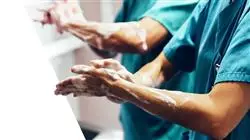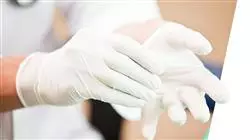University certificate
The world's largest faculty of nursing”
Introduction to the Program
Update your knowledge on Drug Safety and Prevention Systems, in a 100% online modality and in the comfort of your home"

Healthcare organizations should focus on the attitude and behavior of healthcare professionals towards patient safety. Safety culture is developed through effective communication, transparency and staff training. A positive culture helps prevent errors and adverse events, as well as promote continuous improvement of care processes.
For this reason,TECH has designed a Postgraduate diploma in Patient and Organizational Safety for Nursing with the aim of providing students with the necessary skills to be able to perform their work with the highest possible quality. Thus, throughout the program, aspects such as Environmental Safety in Healthcare Centers, ERAS Strategies, Safety in Surgery and Palliative Care will be addressed.
All this, thanks to a convenient 100% online mode that allows students to carry out their studies, being able to combine them with their other work and interests. Furthermore, the study plan includes practical activities and the most innovative and complete didactic materials available in the current academic market.
Become an expert in Patient and Organizational Safety in only 6 months and with total freedom in your schedules"
This Postgraduate diploma in Patient and Organizational Safety for Nursing contains the most complete and up-to-date scientific program on the market. The most important features include:
- The development of case studies presented by healthcare experts in Patient and Organizational Safety
- The graphic, schematic and eminently practical contents with which it is conceived gather scientific and practical information on those disciplines that are indispensable for professional practice
- Practical exercises where the self-assessment process can be carried out to improve learning
- Its special emphasis on innovative methodologies
- Theoretical lessons, questions for experts, discussion forums on controversial issues and individual reflection work
- Content that is accessible from any fixed or portable device with an Internet connection
Maximize your professional profile in the field of Nursing, deepening in areas such as Neonatal Safety, through your Tablet, Mobile or Computer"
The program’s teaching staff includes professionals from the industry who contribute their work experience to this program, as well as renowned specialists from leading societies and prestigious universities.
The multimedia content, developed with the latest educational technology, will provide the professional with situated and contextual learning, i.e., a simulated environment that will provide immersive education programmed to learn in real situations.
The design of this program focuses on Problem-Based Learning, by means of which the professional must try to solve the different professional practice situations that are presented throughout the academic course. For this purpose, the students will be assisted by an innovative interactive video system created by renowned and experienced experts.
Update your skills in one of the most promising areas of Nursing, thanks to TECH, the largest digital university in the world"

Acquire new and better skills on aspects such as Microbiological Sampling Methods of Environmental Biosafety in a 100% online modality"
Why study at TECH?
TECH is the world’s largest online university. With an impressive catalog of more than 14,000 university programs available in 11 languages, it is positioned as a leader in employability, with a 99% job placement rate. In addition, it relies on an enormous faculty of more than 6,000 professors of the highest international renown.

Study at the world's largest online university and guarantee your professional success. The future starts at TECH”
The world’s best online university according to FORBES
The prestigious Forbes magazine, specialized in business and finance, has highlighted TECH as “the world's best online university” This is what they have recently stated in an article in their digital edition in which they echo the success story of this institution, “thanks to the academic offer it provides, the selection of its teaching staff, and an innovative learning method aimed at educating the professionals of the future”
A revolutionary study method, a cutting-edge faculty and a practical focus: the key to TECH's success.
The most complete study plans on the university scene
TECH offers the most complete study plans on the university scene, with syllabuses that cover fundamental concepts and, at the same time, the main scientific advances in their specific scientific areas. In addition, these programs are continuously being updated to guarantee students the academic vanguard and the most in-demand professional skills. In this way, the university's qualifications provide its graduates with a significant advantage to propel their careers to success.
TECH offers the most comprehensive and intensive study plans on the current university scene.
A world-class teaching staff
TECH's teaching staff is made up of more than 6,000 professors with the highest international recognition. Professors, researchers and top executives of multinational companies, including Isaiah Covington, performance coach of the Boston Celtics; Magda Romanska, principal investigator at Harvard MetaLAB; Ignacio Wistumba, chairman of the department of translational molecular pathology at MD Anderson Cancer Center; and D.W. Pine, creative director of TIME magazine, among others.
Internationally renowned experts, specialized in different branches of Health, Technology, Communication and Business, form part of the TECH faculty.
A unique learning method
TECH is the first university to use Relearning in all its programs. It is the best online learning methodology, accredited with international teaching quality certifications, provided by prestigious educational agencies. In addition, this disruptive educational model is complemented with the “Case Method”, thereby setting up a unique online teaching strategy. Innovative teaching resources are also implemented, including detailed videos, infographics and interactive summaries.
TECH combines Relearning and the Case Method in all its university programs to guarantee excellent theoretical and practical learning, studying whenever and wherever you want.
The world's largest online university
TECH is the world’s largest online university. We are the largest educational institution, with the best and widest online educational catalog, one hundred percent online and covering the vast majority of areas of knowledge. We offer a large selection of our own degrees and accredited online undergraduate and postgraduate degrees. In total, more than 14,000 university degrees, in eleven different languages, make us the largest educational largest in the world.
TECH has the world's most extensive catalog of academic and official programs, available in more than 11 languages.
Google Premier Partner
The American technology giant has awarded TECH the Google Google Premier Partner badge. This award, which is only available to 3% of the world's companies, highlights the efficient, flexible and tailored experience that this university provides to students. The recognition as a Google Premier Partner not only accredits the maximum rigor, performance and investment in TECH's digital infrastructures, but also places this university as one of the world's leading technology companies.
Google has positioned TECH in the top 3% of the world's most important technology companies by awarding it its Google Premier Partner badge.
The official online university of the NBA
TECH is the official online university of the NBA. Thanks to our agreement with the biggest league in basketball, we offer our students exclusive university programs, as well as a wide variety of educational resources focused on the business of the league and other areas of the sports industry. Each program is made up of a uniquely designed syllabus and features exceptional guest hosts: professionals with a distinguished sports background who will offer their expertise on the most relevant topics.
TECH has been selected by the NBA, the world's top basketball league, as its official online university.
The top-rated university by its students
Students have positioned TECH as the world's top-rated university on the main review websites, with a highest rating of 4.9 out of 5, obtained from more than 1,000 reviews. These results consolidate TECH as the benchmark university institution at an international level, reflecting the excellence and positive impact of its educational model.” reflecting the excellence and positive impact of its educational model.”
TECH is the world’s top-rated university by its students.
Leaders in employability
TECH has managed to become the leading university in employability. 99% of its students obtain jobs in the academic field they have studied, within one year of completing any of the university's programs. A similar number achieve immediate career enhancement. All this thanks to a study methodology that bases its effectiveness on the acquisition of practical skills, which are absolutely necessary for professional development.
99% of TECH graduates find a job within a year of completing their studies.
Postgraduate Diploma in Patient and Organizational Safety for Nursing
Patient safety is a fundamental aspect of healthcare, and it is a topic that has become increasingly relevant in recent years. The need to ensure patient safety has led to the creation of specific educational programs, which is why TECH Global University presents the Postgraduate Diploma in Patient and Organizational Safety for Nursing. This postgraduate program is designed to qualify nurses in the field of patient safety, equipping them with the skills and knowledge necessary to ensure that healthcare is delivered in a safe and effective manner.
Patient safety is not only limited to the clinical setting, but is also a key aspect in the management of healthcare organizations as a whole. This postgraduate program offered by TECH is taught online, which allows participants to study from anywhere and at any time. In addition, it has a faculty of professional University Experts in the field of Patient Safety and in the nursing sector, who will provide up-to-date and quality information. If you are passionate about nursing and want to contribute to a safer and more effective health care, do not hesitate to take part in this Postgraduate Diploma in Patient and Organizational Safety for Nursing from TECH Global University and become a reference in your field!







